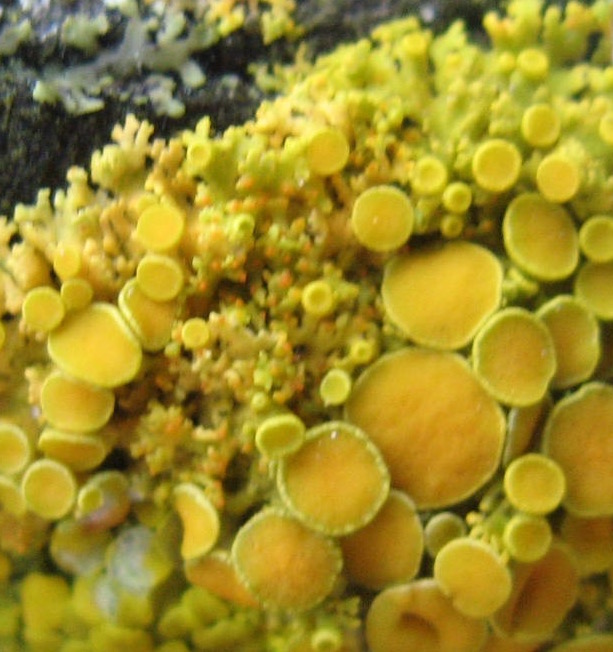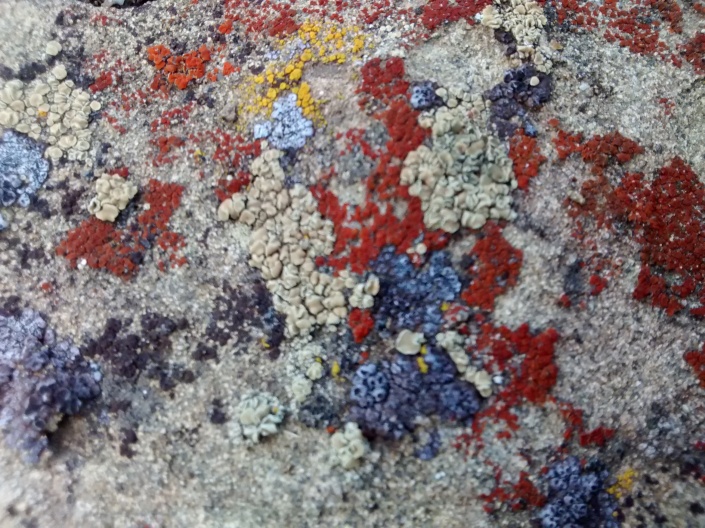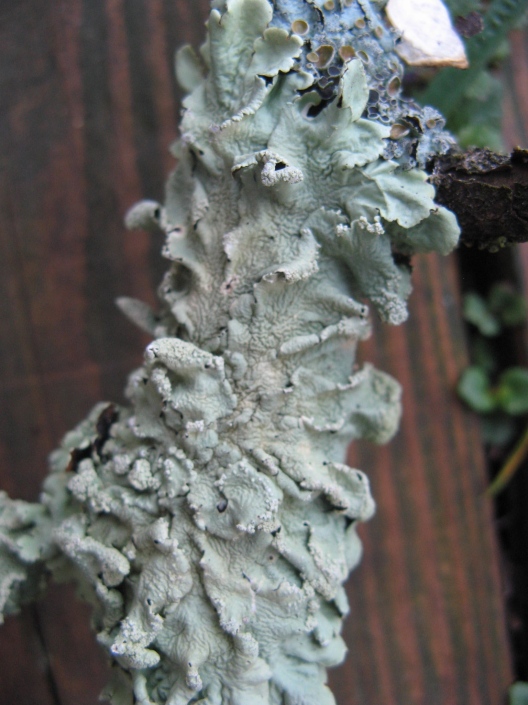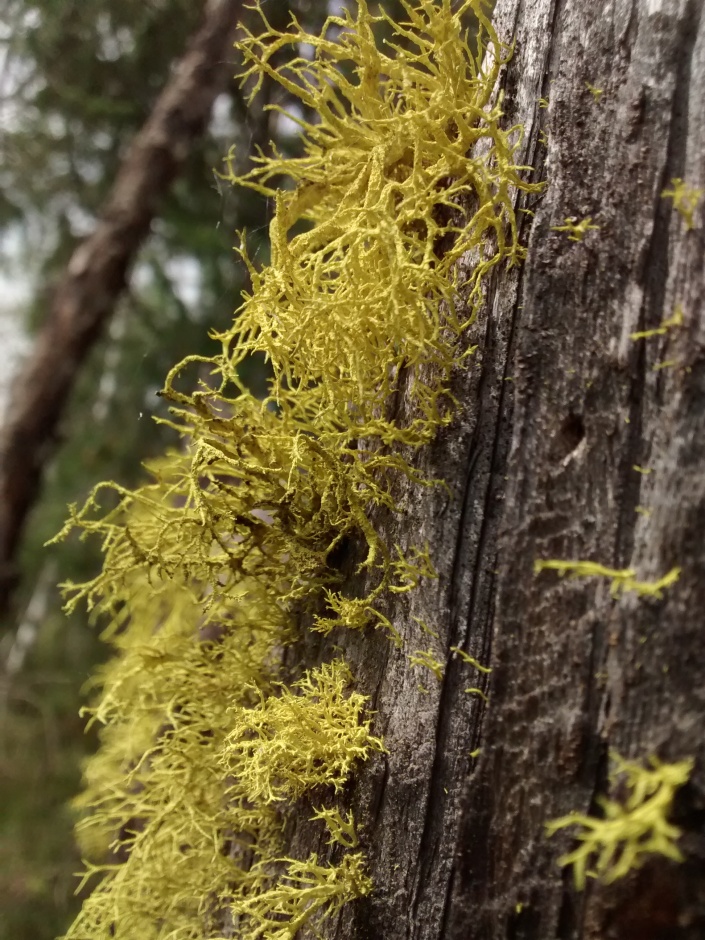What is a Lichen?
Lichens are composite, symbiotic organisms made up from members of as many as three kingdoms. Fungi, algae and/or bacteria.
The Fungi are incapable of making their own food. They usually provide for themselves as parasites or decomposers. But sometimes fungi join with bacteria or algae to form a lichen, a unique life form where each partner adapts to make a new way to live.
“Lichens are the most overlooked of the conspicuous organisms in the natural landscape. The eye often cannot see what the mind does not already know.” – Sharnoff, Lichens of North America

The lichen fungi (kingdom Fungi) associate with partners that manufacture food by photosynthesis. Sometimes the partners are algae (kingdom Protista), other times cyanobacteria (kingdom Monera). Sometimes members of all three kingdoms join together to make a lichen. The bacteria/algae manufacture food, the fungi create a structure for both to live in and the fungi may be in control of reproduction. Many fungi in lichens are unable to live without their partners but some fungi can be found both as individual life forms and as lichens when joined with partners from other kingdoms.
Even this description is in question at the present time. Lichen are so complex that scientists are continually finding new functions and relationships that do not fit prior understanding of what a lichen is or does. Check back with us for updates on this frontier.
Lichen Reproduction
Lichen reproduce by several methods. Lichens are unique in that they have many methods of reproduction, and even can change from one method to another, in some circumstances. Here are a few ways lichens reproduce themselves:
A small piece of the lichen breaks off and scatters.
*Some lichen make spores of the fungal part that are released to the wind. These need to find the right bacteria or algae partner to start life again as a lichen.
Some make tiny non-sexual packets of material that break away from the main body and start a new organism.
Why Learn About Lichens?
First, lichens are fun! They are a mystery, right there in plain sight but usually overlooked by humans. They are a patch of color from a distance, yet are a complex living system that affects the whole world. Really. Here are some of the ways they are important:
Lichen are a pioneer species that colonize places hard for other life to live in; rock, bark, even metal and plastic. They are able to survive in extreme conditions of heat, cold and dryness, regaining function within hours when exposed to moisture and more moderate temperatures. They make the surface of the earth able to support other life. Lichens are…
- Pollution Monitors: Lichen are “like little sponges, taking up everything in the air”, are extremely sensitive to air pollution and so are early indicators of bad air quality. Lichen need very clean environments, a stable place that doesn’t decompose or move quickly, and occasional moisture. Cyanobacteria can take nitrogen gas from the air and turn it into biologically usable compounds, so lichens with these partners make major contributions to soil fertility. Lichen usually grow extremely slowly, about 1mm/year.
- Chemists: They create over 500 chemicals that humans know about. From dye to animal and human food and medicine (possibly half of all lichens have antibiotic properties), geological dating to air quality monitoring lichen have many uses for humans as well as are possibly essential in the web of life everywhere on the planet.
- Food Producers:We are interested in lichens because they are a critical part of life for almost every category of life- microbes, insects, birds, rodents, large and small mammals, trees and other plants and humans too. Even though the use or interaction with lichen may be occasional or a small percentage of another creature’s life it may be critical for survival. The loss of lichen in every part of the world is one of the reasons many other plants and animals are disappearing. Here in the Kickapoo Valley Reserve we hope learning about lichen will improve our understanding of the world we depend on and therefore improve our ability to care for the living systems that support our lives.
This observation reflects our reasons for learning about lichens and illustrates the global import of this life form:
In a striking example from northern Sweden, birds, invertebrates, lichens were all found to be functionally connected and all were impacted by forestry practices. (Pettersson, et. al, 1995)
The authors state that, “Natural forests had greater invertebrate diversity than managed forests and nearly five times as many invertebrates per branch…The number and biomass of invertebrates were related to the number of lichens, even after controlling for sampling location and branch size. Other studies have implicated forestry in the decline of non-migratory passerine birds in northern Europe through the destruction and fragmentation of forests, but ourstudy indicates that it may also reduce foraging habitat quality through a reduction in lichen abundance.” It might be reasonable to postulate similar effects in North America.
• Lichens are beautiful! From a distance, enjoy the unlimited color variations of lichens. Come closer, and notice the patterns they make on rocks and the shapes they form on branches and on the ground. Then pick up your hand lens and peak at the real shapes, textures and colors of the lichens. The variations are endless, beautiful, and hold unexplored mysteries. Enjoy!
Lichen Forms
There are three basic lichen forms that may be found in the Kickapoo Valley Reserve, but there are other variations of form that lichens will make at times. Here are the three basic forms:
Crustose lichen are integrated into the strata they live on so tightly they cannot be removed intact. They are flat, usually having only an upper surface.

Foliose lichen have a leafy shape, are loosely or partially attached to a surface. They have a top and bottom surface, just like a leaf.

Fruticose lichen are usually round in cross section and often look like little shrubs or masses of strands. They grow upward or hang in long strands.

We welcome anyone to share in finding and learning about lichens in the Kickapoo Valley Reserve. We can look at lichens any time of the year. Winter is a great time to see lichens that are on tree trunks or exposed rocks, as there are no leaves hiding the surfaces. Contact me or anyone at the KVR; let’s go lichen hikin’!
The KVR Lichen Project is focused on education and enjoyment of lichens. We are not experts, we are fellow-residents of these hills and woods fascinated with lichens, so as we become familiar with lichens and some of their ways, we will also learn their human-given names, but taxonomy is not our strongest suit; we are focused on fun! See our page on what we do in the KVR with lichens.
